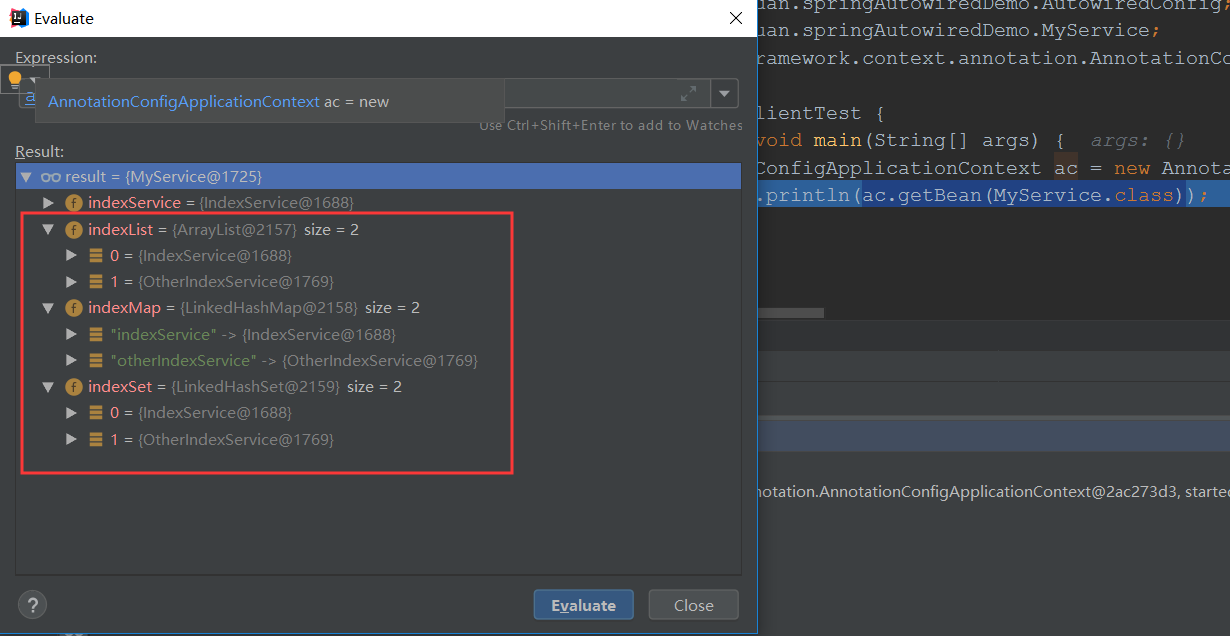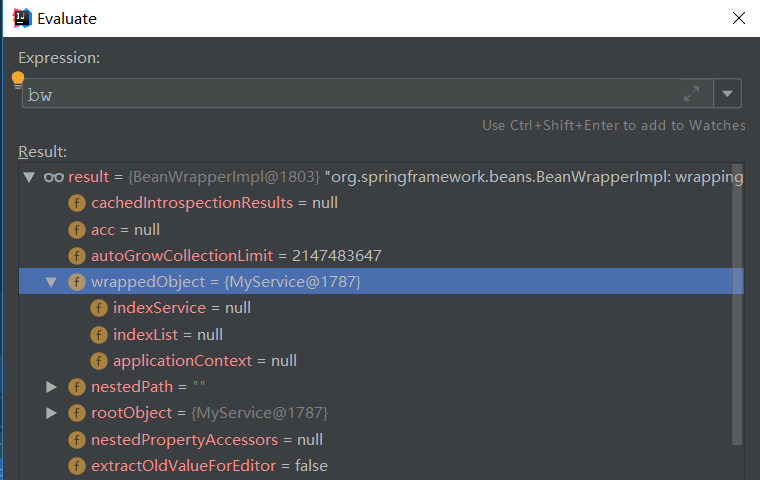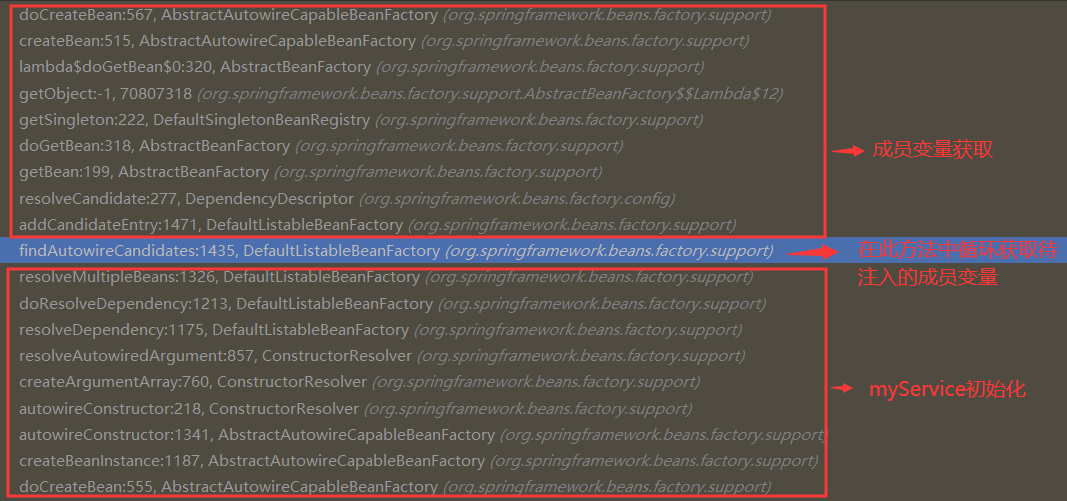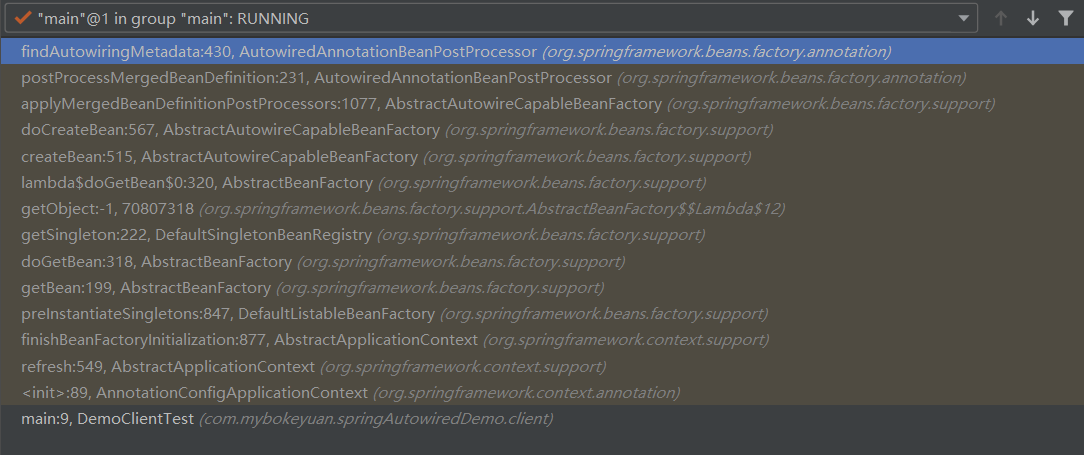前言
说起Spring的@Autowired注解,想必大家已经熟悉的不能再熟悉了。本文就针对此最常用的注解,梳理一下它的功能和原理,争取从源码的角度将此注解讲通,如有写的不准确的地方,欢迎各位园友拍砖。
注:此篇博文基于Spring5.1.10.RELEASE,SpringBoot2.1.9.RELEASE
正文
首先看一下@Autowired注解的源码
1 package org.springframework.beans.factory.annotation; 2 3 import java.lang.annotation.Documented; 4 import java.lang.annotation.ElementType; 5 import java.lang.annotation.Retention; 6 import java.lang.annotation.RetentionPolicy; 7 import java.lang.annotation.Target; 8 9 @Target({ElementType.CONSTRUCTOR, ElementType.METHOD, ElementType.PARAMETER, ElementType.FIELD, ElementType.ANNOTATION_TYPE}) 10 @Retention(RetentionPolicy.RUNTIME) 11 @Documented 12 public @interface Autowired { 13 14 /** 15 * Declares whether the annotated dependency is required. 16 * <p>Defaults to {@code true}. 17 */ 18 boolean required() default true; 19 20 }
可以看到,此注解运行时生效,且适用范围很广,从构造器,到方法,到参数、属性、注解,都可以加上@Autowired注解。它还有一个属性required,此属性用于控制如果找不到要依赖注入的对象时是否报错,默认true即默认找不到要注入的对象时会报错。下面我们慢慢梳理,将@Autowired的使用场景一一罗列出来。
一、普通用法,依赖注入成员变量
下面将要用的测试类贴出来,首先是接口
1 package com.mybokeyuan.springAutowiredDemo; 2 3 public interface IndexInterface { 4 }
再就是两个子类
1 package com.mybokeyuan.springAutowiredDemo; 2 3 import org.springframework.stereotype.Component; 4 5 @Component 6 public class IndexService implements IndexInterface{ 7 8 }
1 package com.mybokeyuan.springAutowiredDemo; 2 3 import org.springframework.stereotype.Component; 4 5 @Component 6 public class OtherIndexService implements IndexInterface{ 7 8 }
核心类(后续的各种场景演示均只基于此类进行改动)
1 package com.mybokeyuan.springAutowiredDemo; 2 3 import org.springframework.beans.factory.annotation.Autowired; 4 import org.springframework.stereotype.Component; 5 6 @Component 7 public class MyService { 8 9 @Autowired 10 private IndexService indexService; 11 12 }
扫描配置类
1 package com.mybokeyuan.springAutowiredDemo; 2 3 import org.springframework.context.annotation.ComponentScan; 4 import org.springframework.context.annotation.Configuration; 5 6 @Configuration 7 @ComponentScan("com.mybokeyuan.springAutowiredDemo") 8 public class AutowiredConfig { 9 }
main方法类
1 package com.mybokeyuan.springAutowiredDemo.client; 2 3 import com.mybokeyuan.springAutowiredDemo.AutowiredConfig; 4 import com.mybokeyuan.springAutowiredDemo.MyService; 5 import org.springframework.context.annotation.AnnotationConfigApplicationContext; 6 7 public class DemoClientTest { 8 public static void main(String[] args) { 9 AnnotationConfigApplicationContext ac = new AnnotationConfigApplicationContext(AutowiredConfig.class); 10 System.out.println(ac.getBean(MyService.class)); 11 12 } 13 }
运行main方法时,如果在第10行打了断点,会看到MyService中的indexService属性已经依赖注入了值,这是我们最常使用@Autowired注解的场景。
二、依赖注入方法
MyService类如下所示
1 package com.mybokeyuan.springAutowiredDemo; 2 3 import org.springframework.beans.factory.annotation.Autowired; 4 import org.springframework.context.ApplicationContext; 5 import org.springframework.stereotype.Component; 6 7 import java.util.List; 8 9 @Component 10 public class MyService { 11 12 private IndexService indexService; 13 14 @Autowired 15 public void getIndexInterf (IndexService index) { 16 indexService = index; 17 } 18 19 @Autowired 20 private ApplicationContext applicationContext; 21 22 }
运行main方法后,会发现该类中的indexService完成了注入,这样的用法类似于set方法的功能。并且可以看到,applicationContext也注入了。所以往后就不要用ApplicationContextAware了,直接@Autowired轻快便捷的达到目的。
三、构造方法注入参数
MyService类如下所示:
1 package com.mybokeyuan.springAutowiredDemo; 2 3 import org.springframework.beans.factory.annotation.Autowired; 4 import org.springframework.stereotype.Component; 5 6 import java.util.List; 7 8 @Component 9 public class MyService { 10 11 12 private IndexService indexService; 13 14 private List<IndexInterface> indexList; 15 16 @Autowired 17 public MyService (List<IndexInterface> indexList, IndexService indexService) { 18 this.indexList = indexList; 19 this.indexService = indexService; 20 } 21 }
运行后会发现成员变量indexList和indexService中已经注入了值。此处需要注意一点,如果有两个自定义构造方法,两个都没加@Autowired注解,则会报错,因为Spring不知道你要用哪个构造方法初始化;
如果只有一个构造方法加了@Autowired注解,那么就会用这个构造方法初始化;同理,如果有多个构造方法都加了@Autowired注解,那么还是会报错。
四、注入Map、List等集合
在【一、普通用法】中的MyService里添加几个成员变量,如下所示:
1 package com.mybokeyuan.springAutowiredDemo; 2 3 import org.springframework.beans.factory.annotation.Autowired; 4 import org.springframework.stereotype.Component; 5 6 import java.util.List; 7 import java.util.Map; 8 import java.util.Set; 9 10 @Component 11 public class MyService { 12 13 @Autowired 14 private IndexService indexService; 15 16 @Autowired 17 private List<IndexInterface> indexList; 18 19 @Autowired 20 private Map<String, IndexInterface> indexMap; 21 22 @Autowired 23 private Set<IndexInterface> indexSet; 24 }
再次运行main方法,在断点中可以看到从Spring中获取到的MyService对象中,已经完成了对后面三个集合的依赖注入,如下图所示:

可以看到,IndexInterface接口的两个实现类全部注入到了集合中,且Map里面的key默认就是两个实现类各自的beanName。
五、源码分析
看了上面的各种使用场景,想必大家会对这个最熟悉的注解有了一丝陌生的感觉,不过不要紧,下面咱们慢慢来脱下TA的神秘衣服,对ta重新熟悉起来。我这里是以下面的MyService类为例子进行的源码debug分析。
1 package com.mybokeyuan.springAutowiredDemo; 2 3 import org.springframework.beans.factory.annotation.Autowired; 4 import org.springframework.context.ApplicationContext; 5 import org.springframework.stereotype.Component; 6 7 import java.util.List; 8 9 @Component 10 public class MyService { 11 12 13 private IndexService indexService; 14 15 private List<IndexInterface> indexList; 16 17 @Autowired 18 public void getIndexInterf (IndexService index) { 19 indexService = index; 20 } 21 22 @Autowired 23 private ApplicationContext applicationContext; 24 25 @Autowired 26 public MyService (List<IndexInterface> indexList) { 27 this.indexList = indexList; 28 } 29 }
首先在AutowiredAnnotationBeanPostProcessor#postProcessProperties的方法中打上一个断点,然后右键断点加上条件过滤 beanName.equals("myService"),debug运行main方法,会在断点处停住,此时我们的调用栈是下图这样的:

相信对Spring源码有过了解的园友对调用栈中的方法都不陌生,从下往上看,先经过了refresh方法,在finishBeanFactoryInitialization方法中getBean,然后走getObject的时候触发bean的初始化。
bean的初始化是一个很复杂地方,在AbstractAutowireCapableBeanFactory#doCreateBean方法中,先创建一个BeanWrapper,它的内部成员变量wrappedObject中存放的就是实例化的MyService对象,只是此时未完成初始化,所以属性都是null(如下图所示)。再往后进入populateBean方法进行属性注入,这才逐渐逼近我们的目的地。

不过在进入populateBean之前,需要先去看一下前置方法,即BeanWrapper创建的方法createBeanInstance。Spring在这个方法中先推断出合适的构造方法,然后实例化bean。在推断构造方法的时候(AbstractAutowireCapableBeanFactory#determineConstructorsFromBeanPostProcessors方法中调用了AutowiredAnnotationBeanPostProcessor#determineCandidateConstructors方法进行的推断),有一个筛选标准就是会根据是否有@Autowired注解来选择用哪个构造器,具体详见AutowiredAnnotationBeanPostProcessor#findAutowiredAnnotation方法,此方法如下所示,功能就是看看当前构造器上加没加注解。
1 @Nullable 2 private AnnotationAttributes findAutowiredAnnotation(AccessibleObject ao) { 3 if (ao.getAnnotations().length > 0) { // autowiring annotations have to be local 4 for (Class<? extends Annotation> type : this.autowiredAnnotationTypes) {// 此集合中只有两个值,一个是Autowired注解,一个是Value注解 5 AnnotationAttributes attributes = AnnotatedElementUtils.getMergedAnnotationAttributes(ao, type); 6 if (attributes != null) { 7 return attributes; 8 } 9 } 10 } 11 return null; 12 }
此处构造器的推断和属性注入,就是使用场景三【三、构造方法注入参数】中,@Autowired注解加在构造器上发挥的作用。
走完createBeanInstance方法得到的BeanWrapper中,可以看到属性wrappedObject中已经对indexList进行了依赖注入

进行到这里,有必要重新梳理清楚类构造器注入时的调用关系,示例的调用栈图如下所示:

1、在myService对象进行实例化调用构造器时,执行AbstractAutowireCapableBeanFactory#autowireConstructor方法;
2、进入到另一个类ConstructorResolver的autowireConstructor方法中;
2.1、调用同类下的resolveAutowiredArgument方法,该方法会调用DefaultListableBeanFactory下的resolveDependency方法,此方法会调用到findAutowireCandidates方法,在该方法中有如下代码
1 for (String candidate : candidateNames) {
2 if (!isSelfReference(beanName, candidate) && isAutowireCandidate(candidate, descriptor)) {
3 addCandidateEntry(result, candidate, descriptor, requiredType);
4 }
5 }
其中的candidateNames就是构造器中要注入的对象名字indexService和otherIndexService,此处通过循环调用addCandidateEntry来获取这两个name对应的bean;
2.2、在DefaultListableBeanFactory的addCandidateEntry方法中,调到了DependencyDescriptor#resolveCandidate方法,在此方法中调用的getBean方法获取它的成员变量bean。
DependencyDescriptor#resolveCandidate方法如下所示:
1 public Object resolveCandidate(String beanName, Class<?> requiredType, BeanFactory beanFactory)
2 throws BeansException {
3
4 return beanFactory.getBean(beanName);
5 }
然后又进入了下一次的getBean逻辑。此处就是这样完成的构造器方法参数注入。
下面进入populateBean中。看源码经过一个for循环和一个NAME或者TYPE模式的判断之后,进入了BeanPostProcessor的循环调用中,通过遍历后置处理器,调用了AutowiredAnnotationBeanPostProcessor#postProcessProperties,也就是一开始我们打断点的地方,该方法源码如下:
1 @Override
2 public PropertyValues postProcessProperties(PropertyValues pvs, Object bean, String beanName) {
3 InjectionMetadata metadata = findAutowiringMetadata(beanName, bean.getClass(), pvs);
4 try {
5 metadata.inject(bean, beanName, pvs);
6 }
7 catch (BeanCreationException ex) {
8 throw ex;
9 }
10 catch (Throwable ex) {
11 throw new BeanCreationException(beanName, "Injection of autowired dependencies failed", ex);
12 }
13 return pvs;
14 }
在第13行打断点,发现到13行的时候,bean中的属性已经被注入了,所以可以知道,是在第5行进行的属性注入。
继续跟踪第5行,进入InjectionMetadata#inject方法:
1 public void inject(Object target, @Nullable String beanName, @Nullable PropertyValues pvs) throws Throwable {
2 Collection<InjectedElement> checkedElements = this.checkedElements;
3 Collection<InjectedElement> elementsToIterate =
4 (checkedElements != null ? checkedElements : this.injectedElements);
5 if (!elementsToIterate.isEmpty()) {
6 for (InjectedElement element : elementsToIterate) {
7 if (logger.isTraceEnabled()) {
8 logger.trace("Processing injected element of bean '" + beanName + "': " + element);
9 }
10 element.inject(target, beanName, pvs);
11 }
12 }
13 }
发现是从当前metadata对象中取的element对象,而通过断点可以看到,checkedElements中的Member对象就是当前bean中加了@Autowired注解的成员变量或者普通方法在反射包中对应的对象,随后通过element的inject方法进行的注入。那么问题来了,element对象是如何创建来的?inject方法又是如何将bean注入到成员变量中的?
对于element对象的创建,还要返回postProcessProperties方法中查看上面的findAutowiringMetadata方法:
1 private InjectionMetadata findAutowiringMetadata(String beanName, Class<?> clazz, @Nullable PropertyValues pvs) {
2 // Fall back to class name as cache key, for backwards compatibility with custom callers.
3 String cacheKey = (StringUtils.hasLength(beanName) ? beanName : clazz.getName());
4 // Quick check on the concurrent map first, with minimal locking.
5 InjectionMetadata metadata = this.injectionMetadataCache.get(cacheKey);
6 if (InjectionMetadata.needsRefresh(metadata, clazz)) {
7 synchronized (this.injectionMetadataCache) {
8 metadata = this.injectionMetadataCache.get(cacheKey);
9 if (InjectionMetadata.needsRefresh(metadata, clazz)) {
10 if (metadata != null) {
11 metadata.clear(pvs);
12 }
13 metadata = buildAutowiringMetadata(clazz);
14 this.injectionMetadataCache.put(cacheKey, metadata);
15 }
16 }
17 }
18 return metadata;
19 }
通过断点到这个方法中,发现此时injectionMetadataCache中已经有了myService对应的InjectionMetadata,此方法只是从map中取出返回。没办法了,还要继续追寻下去,AutowiredAnnotationBeanPostProcessor中的injectionMetadataCache属性是什么时候触发的初始化?
在当前类中查询injectionMetadataCache的put方法,发现只有这一个地方,所以继续在这里断点一下,看看什么时候触发的injectionMetadataCache.put。

发现原来就是在doCreateBean的applyMergedBeanDefinitionPostProcessors方法中触发的put操作。
下面继续追寻inject方法中Spring如何完成的属性注入。
属性注入进入内部类 AutowiredFieldElement的方法inject中,方法注入进入的是AutowiredMethodElement中。在inject方法中可以看到我们的老朋友DefaultListableBeanFactory#resolveDependency方法,即通过这个方法获取到对应的bean对象,最后通过反射完成的赋值或方法调用。
这里我们第二次遇到DefaultListableBeanFactory#resolveDependency,发现它是@Autowired注解注入构造器参数、注入成员变量、注入方法参数必经的方法,所以必须继续搞明白它。
追踪resolveDependency方法,进入DefaultListableBeanFactory#resolveMultipleBeans方法,该方法属于@Autowired注解的核心方法,虽然很长,但需要贴出源代码:
1 @Nullable 2 private Object resolveMultipleBeans(DependencyDescriptor descriptor, @Nullable String beanName, 3 @Nullable Set<String> autowiredBeanNames, @Nullable TypeConverter typeConverter) { 4 5 final Class<?> type = descriptor.getDependencyType(); 6 // 0、暂时不清楚是做什么用的... 7 if (descriptor instanceof StreamDependencyDescriptor) { 8 Map<String, Object> matchingBeans = findAutowireCandidates(beanName, type, descriptor); 9 if (autowiredBeanNames != null) { 10 autowiredBeanNames.addAll(matchingBeans.keySet()); 11 } 12 Stream<Object> stream = matchingBeans.keySet().stream() 13 .map(name -> descriptor.resolveCandidate(name, type, this)) 14 .filter(bean -> !(bean instanceof NullBean)); 15 if (((StreamDependencyDescriptor) descriptor).isOrdered()) { 16 stream = stream.sorted(adaptOrderComparator(matchingBeans)); 17 } 18 return stream; 19 } 20 else if (type.isArray()) { // 1、判断要注入的是不是一个数组,可见除了集合注入外,也可以以数组的形式注入bean 21 Class<?> componentType = type.getComponentType(); 22 ResolvableType resolvableType = descriptor.getResolvableType(); 23 Class<?> resolvedArrayType = resolvableType.resolve(type); 24 if (resolvedArrayType != type) { 25 componentType = resolvableType.getComponentType().resolve(); 26 } 27 if (componentType == null) { 28 return null; 29 } 30 Map<String, Object> matchingBeans = findAutowireCandidates(beanName, componentType, 31 new MultiElementDescriptor(descriptor)); 32 if (matchingBeans.isEmpty()) { 33 return null; 34 } 35 if (autowiredBeanNames != null) { 36 autowiredBeanNames.addAll(matchingBeans.keySet()); 37 } 38 TypeConverter converter = (typeConverter != null ? typeConverter : getTypeConverter()); 39 Object result = converter.convertIfNecessary(matchingBeans.values(), resolvedArrayType); 40 if (result instanceof Object[]) { 41 Comparator<Object> comparator = adaptDependencyComparator(matchingBeans); 42 if (comparator != null) { 43 Arrays.sort((Object[]) result, comparator); 44 } 45 } 46 return result; 47 } 48 else if (Collection.class.isAssignableFrom(type) && type.isInterface()) { // 2、判断注入的是不是集合的接口类(List、Set等) 49 Class<?> elementType = descriptor.getResolvableType().asCollection().resolveGeneric(); 50 if (elementType == null) { 51 return null; 52 } 53 Map<String, Object> matchingBeans = findAutowireCandidates(beanName, elementType, 54 new MultiElementDescriptor(descriptor)); 55 if (matchingBeans.isEmpty()) { 56 return null; 57 } 58 if (autowiredBeanNames != null) { 59 autowiredBeanNames.addAll(matchingBeans.keySet()); 60 } 61 TypeConverter converter = (typeConverter != null ? typeConverter : getTypeConverter()); 62 Object result = converter.convertIfNecessary(matchingBeans.values(), type); 63 if (result instanceof List) { 64 Comparator<Object> comparator = adaptDependencyComparator(matchingBeans); 65 if (comparator != null) { 66 ((List<?>) result).sort(comparator); 67 } 68 } 69 return result; 70 } 71 else if (Map.class == type) { ///3、判断要注入的是不是map类 72 ResolvableType mapType = descriptor.getResolvableType().asMap(); 73 Class<?> keyType = mapType.resolveGeneric(0); 74 if (String.class != keyType) { 75 return null; 76 } 77 Class<?> valueType = mapType.resolveGeneric(1); 78 if (valueType == null) { 79 return null; 80 } 81 Map<String, Object> matchingBeans = findAutowireCandidates(beanName, valueType, 82 new MultiElementDescriptor(descriptor)); 83 if (matchingBeans.isEmpty()) { 84 return null; 85 } 86 if (autowiredBeanNames != null) { 87 autowiredBeanNames.addAll(matchingBeans.keySet()); 88 } 89 return matchingBeans; 90 } 91 else { // 4、其他情况返回空,进入doResolveDependency方法做默认处理 92 return null; 93 } 94 }
主要看1/2/3的注释,可以知道Spring支持多种注入方式就是在这里实现的。我们能发现,在获取bean的时候都是调用了findAntowireCandidates方法,而且第4中默认的情况,在外部的doResolveDenpency方法中也调用了findAutowireCandidates方法。
至于findAutowireCandidates方法是如何完成的属性获取?是通过type还是name获取到的bean?我们下期继续!